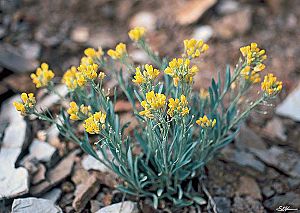Dudley Bluffs twinpod facts for kids
Quick facts for kids Dudley Bluffs twinpod |
|
|---|---|
 |
|
| Conservation status | |
| Scientific classification | |
| Genus: |
Physaria
|
| Species: |
obcordata
|
The Dudley Bluffs twinpod (Physaria obcordata) is a very rare flowering plant. It belongs to the Brassicaceae family, which also includes plants like cabbage and mustard. This special plant is only found in one small area of Colorado, in a place called the Piceance Basin in Rio Blanco County. When a plant or animal is found only in one specific place, it's called endemic.
The Dudley Bluffs twinpod looks a lot like another plant called the Piceance twinpod (Physaria acutifolia). But if you look closely at their leaves with a magnifying glass, you can tell them apart! The Piceance twinpod has tiny star-shaped hairs. The Dudley Bluffs twinpod has unique markings that look like a small satellite dish or a circle with a dot in the middle. This plant is considered a threatened species in the United States because its home is in danger.
Contents
Discovering the Dudley Bluffs Twinpod
This unique plant was first found in 1982. Scientists officially described it in 1983, giving it its scientific name.
Where Does It Live?
The Dudley Bluffs twinpod lives in a dry, open area called the Piceance Basin. Its home is made of white shale rock from the Green River Formation. This area has been shaped by rivers cutting through the land over many years.
What is Shale?
Much of the rock in this area is oil shale, which contains oil, and there are also large amounts of natural gas underground.
Why is the Plant in Danger?
The biggest threat to the Dudley Bluffs twinpod is human activity. The area where it grows is rich in oil and minerals. Because of this, there's a lot of exploration and mining happening. Companies are looking for and digging up resources like nahcolite and dawsonite.
This mining and drilling activity can harm the plants in many ways:
- Building new roads
- Installing pipelines
- Setting up utilities
- Constructing new buildings and power plants
All these activities can destroy the plant's habitat. Increased pollution and dust from these operations can also hurt the plants. Scientists are very worried about this plant because all of its habitat is in areas where oil and mineral mining could happen.
What Does the Dudley Bluffs Twinpod Look Like?
The Dudley Bluffs twinpod is a perennial plant, which means it lives for more than two years. It's a small herb with stems that grow about 12 to 18 centimeters (about 5 to 7 inches) tall.
Plant Parts
- Leaves: The leaves at the bottom of the plant are wide and shaped like a spear, about 4 to 8 centimeters long. The leaves higher up on the stem are narrower.
- Flowers: The flowers grow in a loose cluster called a raceme. They have yellow-green sepals (the leaf-like parts that protect the bud) and bright yellow petals that can be up to a centimeter long.
- Fruit: After the flowers, the plant produces heart-shaped fruits called siliques. These fruits hang down, are puffed up, and feel like paper. They are about half a centimeter long.
How Does it Get Pollinated?
Like many flowering plants, the Dudley Bluffs twinpod needs help to make seeds. It is pollinated by different types of bees. These bees include those from the genera Halictus, Lasioglossum, Dialictus, and Andrena.
How Many Dudley Bluffs Twinpods Are There?
Even though this plant is rare and only found in a small area, it can be quite common in the specific spots where it grows. For example, one location might have as many as 10,000 individual plants!
Overall, scientists have found about ten different groups of these plants. They estimate there are up to 27,800 individual Dudley Bluffs twinpod plants in total.


